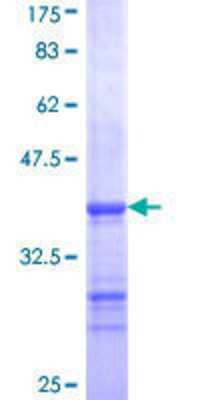PIGA Products
PIGA, also known as Phosphatidylinositol N-acetylglucosaminyltransferase subunit A, has three isoforms that are produced by alternative splicing. Isoform 1, the canonical sequence, is 484 amino acids long and 54 kDa. Isoform 2 and 3 are both shorter isoforms, at 315 and 250 amino acids, respectively. PIGA is a critical player in the synthesis of N-acetylglucosaminyl-phosphatidylinositol, which is the first intermediate in the biosynthesis of GPI anchors. Current research on PIGA is being conducted in relation to several diseases and disorders including Paroxysmal nocturnal hemoglobinuria, which may be caused by mutations in the PIGA gene. Other diseases and disorders related to PIGA include multiple congenital anomalies-hypotonia-seizures syndrome type 2, anemia, Burkitt's lymphoma, hepatic vein thrombosis and Myelodysplastic syndrome. PIGA has been shown to have interactions with DPM2, PIGQ, PIGH, PYURF and PIGP in pathways such as GPI anchor biosynthesis and metabolic pathways.
Show More
4 results for "PIGA" in Products
4 results for "PIGA" in Products
PIGA Products
PIGA, also known as Phosphatidylinositol N-acetylglucosaminyltransferase subunit A, has three isoforms that are produced by alternative splicing. Isoform 1, the canonical sequence, is 484 amino acids long and 54 kDa. Isoform 2 and 3 are both shorter isoforms, at 315 and 250 amino acids, respectively. PIGA is a critical player in the synthesis of N-acetylglucosaminyl-phosphatidylinositol, which is the first intermediate in the biosynthesis of GPI anchors. Current research on PIGA is being conducted in relation to several diseases and disorders including Paroxysmal nocturnal hemoglobinuria, which may be caused by mutations in the PIGA gene. Other diseases and disorders related to PIGA include multiple congenital anomalies-hypotonia-seizures syndrome type 2, anemia, Burkitt's lymphoma, hepatic vein thrombosis and Myelodysplastic syndrome. PIGA has been shown to have interactions with DPM2, PIGQ, PIGH, PYURF and PIGP in pathways such as GPI anchor biosynthesis and metabolic pathways.
Show More
| Reactivity: | Human |
| Details: | Rabbit IgG Polyclonal |
| Applications: | WB |
| Reactivity: | Human |
| Details: | Rabbit IgG Polyclonal |
| Applications: | IHC |
| Applications: | WB, ELISA, MA, AP |
| Reactivity: | Human, Mouse, Rat |
| Details: | Rabbit IgG Polyclonal |
| Applications: | WB |

![Western Blot: PIGA Antibody [NBP1-59701] Western Blot: PIGA Antibody [NBP1-59701]](https://resources.bio-techne.com/images/products/PIGA-Antibody-Western-Blot-NBP1-59701-img0003.jpg)
![Immunohistochemistry-Paraffin: PIGA Antibody [NBP2-13760] Immunohistochemistry-Paraffin: PIGA Antibody [NBP2-13760]](https://resources.bio-techne.com/images/products/PIGA-Antibody-Immunohistochemistry-Paraffin-NBP2-13760-img0006.jpg)

